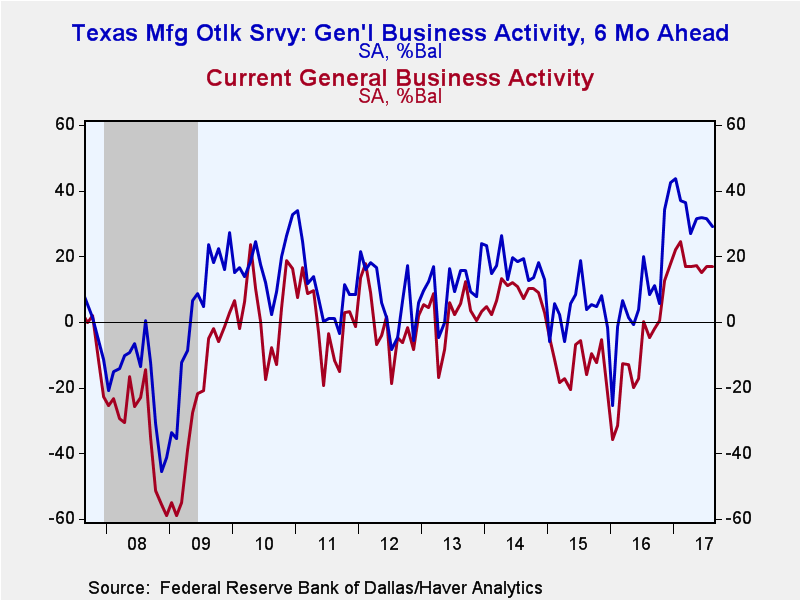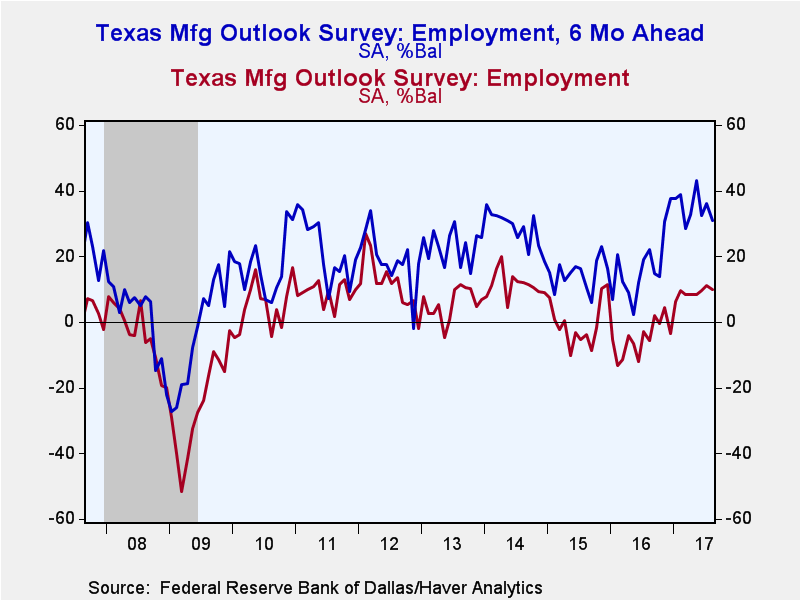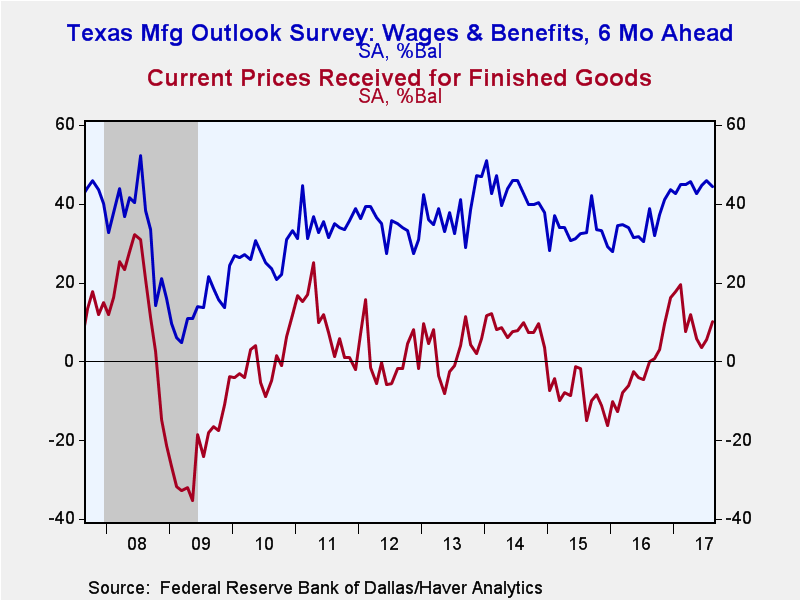 Global| Aug 28 2017
Global| Aug 28 2017Texas Factory Sector Growth Steadies
by:Tom Moeller
|in:Economy in Brief
Summary
The Federal Reserve Bank of Dallas indicated in its Texas Manufacturing Outlook Survey that the August General Business Activity Index rose slightly to 17.0 from 16.8 in July. Nevertheless, the index remained well below the February [...]
The Federal Reserve Bank of Dallas indicated in its Texas Manufacturing Outlook Survey that the August General Business Activity Index rose slightly to 17.0 from 16.8 in July. Nevertheless, the index remained well below the February high of 24.5. The production reading eased m/m, but remained near the expansion high. The growth rate of new orders also slipped. These figures remained, however, significantly higher than the lows of early last year. Shipments eased m/m but remained sharply higher y/y. The number of employees reading also slipped m/m, yet has indicated a fairly steady rate of increase all year. The average workweek lengthened. Capital spending also improved to the highest point since January.
On the pricing front, the index for prices received rose to the highest point since April, but remained below February's peak. Raw materials pricing power also recovered to the highest point in six months. On the labor pricing front, wages & benefits surged and roughly equaled the strongest level of the expansion.
Expectations for business activity in six months softened m/m and remained down sharply versus January's peak. The future production reading also slipped m/m, and was the lowest reading since April. Expected new orders growth stabilized and expected shipments deteriorated. The future order backlogs reading deteriorated sharply. Expected employment eased to its weakest point since March and was down sharply versus May's peak. Expected wages have been roughly unchanged all year, but were up sharply versus the 2016 lows.
Each index is calculated by subtracting the percentage reporting a decrease from the percentage reporting an increase. When all firms report that activity has increased, an index will register 100. An index will register -100 when all firms report a decrease. An index will be zero when the number of firms reporting an increase or decrease is equal. Items may not add up to 100% because of rounding. Data for the Texas Manufacturing Outlook can be found in Haver's SURVEYS database.
| Texas Manufacturing Outlook Survey (SA, % Balance) | Aug | Jul | Jun | Aug'16 | 2016 | 2015 | 2014 |
|---|---|---|---|---|---|---|---|
| Current General Business Activity Index | 17.0 | 16.8 | 15.0 | -4.8 | -8.8 | -12.5 | 8.4 |
| Production | 20.3 | 22.8 | 12.3 | 5.4 | 2.4 | -1.0 | 14.5 |
| Growth Rate of Orders | 11.7 | 12.2 | 4.7 | 4.3 | -7.3 | -11.8 | 4.7 |
| Number of Employees | 9.9 | 11.2 | 9.6 | -5.6 | -4.9 | -0.4 | 11.5 |
| Prices Received for Finished Goods | 10.2 | 5.6 | 3.6 | 0.1 | -1.6 | -8.5 | 8.3 |
| General Business Activity Index Expected in Six Months | 29.2 | 31.6 | 31.9 | 8.5 | 8.9 | 4.1 | 17.4 |
| Production | 43.1 | 48.8 | 47.5 | 33.4 | 35.8 | 31.1 | 42.7 |
| Growth Rate of New Orders | 37.1 | 32.8 | 35.7 | 27.7 | 24.3 | 20.7 | 31.5 |
| Number of Employees | 30.8 | 36.2 | 32.3 | 22.0 | 16.7 | 14.7 | 28.6 |
| Wages & Benefits | 44.3 | 45.9 | 44.7 | 38.9 | 34.8 | 33.2 | 43.1 |
Tom Moeller
AuthorMore in Author Profile »Prior to joining Haver Analytics in 2000, Mr. Moeller worked as the Economist at Chancellor Capital Management from 1985 to 1999. There, he developed comprehensive economic forecasts and interpreted economic data for equity and fixed income portfolio managers. Also at Chancellor, Mr. Moeller worked as an equity analyst and was responsible for researching and rating companies in the economically sensitive automobile and housing industries for investment in Chancellor’s equity portfolio. Prior to joining Chancellor, Mr. Moeller was an Economist at Citibank from 1979 to 1984. He also analyzed pricing behavior in the metals industry for the Council on Wage and Price Stability in Washington, D.C. In 1999, Mr. Moeller received the award for most accurate forecast from the Forecasters' Club of New York. From 1990 to 1992 he was President of the New York Association for Business Economists. Mr. Moeller earned an M.B.A. in Finance from Fordham University, where he graduated in 1987. He holds a Bachelor of Arts in Economics from George Washington University.










